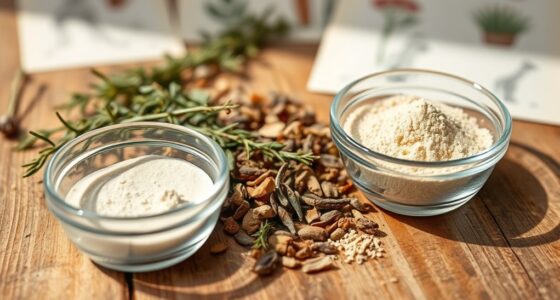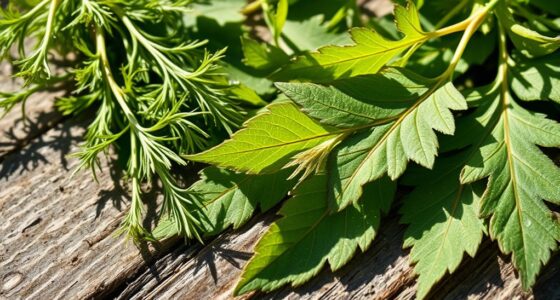Comfrey has a long history as a traditional remedy known for supporting bone healing and tissue repair. You can use its roots externally, in poultices or salves, but avoid raw roots directly on wounds due to potential alkaloid absorption and toxicity risks. Proper preparation is essential for safety, and internal use can be harmful. To understand how to harness its healing powers safely, explore the detailed ways comfrey can work for you.
Key Takeaways
- Comfrey has a longstanding reputation for promoting tissue repair and reducing inflammation in bones and skin.
- Its roots contain potent compounds, but internal use poses risks due to toxic pyrrolizidine alkaloids.
- Topical applications like poultices and salves are traditional methods, but proper preparation is essential for safety.
- Raw comfrey root should be avoided on open wounds to prevent alkaloid absorption and toxicity.
- Consulting herbal experts and following safe extraction practices optimize benefits while minimizing health risks.

Comfrey has been used for centuries as a traditional remedy for wounds, sprains, and skin irritations. Its reputation as a healing plant stems from its ability to promote tissue repair and reduce inflammation. However, if you’re considering using comfrey, it’s essential to understand the importance of herbal safety. Historically, comfrey was often applied directly to the skin, but modern research highlights the potential risks associated with internal use, primarily due to compounds called pyrrolizidine alkaloids. These substances can cause liver damage if consumed in large quantities or over extended periods. As a result, when working with comfrey, you should be cautious and informed about its safe applications.
Comfrey has healing properties but must be used cautiously due to potential liver toxicity from pyrrolizidine alkaloids.
One critical aspect of working with comfrey is the method of root extraction. The roots contain a concentrated amount of active compounds, making them potent but also potentially risky if misused. When harvesting comfrey root, ensure you’re properly identifying the plant to avoid confusion with similar species that might be toxic. After harvesting, the root needs to be carefully cleaned and dried before extraction. Root extraction involves processing the root to obtain the beneficial compounds, often through methods like decoction or infusion. This process allows you to harness the plant’s healing properties without direct contact with the raw root, which might contain higher levels of harmful alkaloids. Proper extraction techniques are essential for maximizing safety and efficacy.
If you’re making a topical preparation, like a poultice or salve, using extracts derived from comfrey root can be safe when applied externally. Just remember that herbal safety isn’t just about the plant itself but also about how you prepare and use it. For example, applying a freshly prepared root extract directly on open wounds isn’t recommended because of the risk of alkaloid absorption. Instead, use well-prepared, strained extracts or commercial preparations that specify their safety profile. When using homemade remedies, always start with small amounts to test for any allergic reactions or sensitivities.
In addition, it’s wise to consult authoritative sources or herbalists when using comfrey, especially if you plan to incorporate it into your health routine regularly. While traditional use has stood the test of time, modern safety standards emphasize moderation and informed application. By understanding the nuances of herbal safety and employing proper root extraction techniques, you can safely enjoy the potential benefits of comfrey without risking adverse effects. Remember, respecting the plant’s potency and knowing how to prepare it properly ensures you maximize its healing abilities while minimizing potential harm.
Frequently Asked Questions
Is Comfrey Safe for Internal Use?
You shouldn’t use comfrey internally because of toxicity concerns. While it has traditional applications for healing bones and wounds, ingesting comfrey can cause liver damage due to compounds called pyrrolizidine alkaloids. Even though some people believe in its benefits, medical advice generally discourages internal use. Always consult a healthcare professional before considering comfrey for internal purposes, as safety risks outweigh traditional claims.
Can Comfrey Treat Broken Bones Effectively?
Ever wonder if herbal efficacy lives up to tradition? While comfrey has long been used for traditional uses like healing wounds and broken bones, scientific evidence isn’t conclusive. It might seem promising, but you shouldn’t rely solely on it for treating broken bones. Always consult a healthcare professional first. Comfrey’s reputation as a “bone-knitter” is rooted in tradition, but modern medicine requires more solid proof before recommending it for such serious injuries.
What Are the Risks of Long-Term Comfrey Use?
Long-term comfrey use poses risks like liver toxicity, which can cause serious damage if you consume it over extended periods. You might also experience herbal interactions with other medications or herbs, increasing side effects or reducing effectiveness. It’s important to use comfrey cautiously and avoid prolonged use without medical guidance, as the potential for liver issues and interactions outweighs its short-term benefits. Always consult a healthcare professional before long-term use.
How Does Comfrey Compare to Modern Bone-Healing Drugs?
Did you know herbal medicine like comfrey has been used for centuries to promote bone regeneration? Compared to modern bone-healing drugs, comfrey’s efficacy is less scientifically proven, but it’s believed to stimulate natural healing processes. While drugs often provide quick, targeted relief, comfrey offers a traditional, holistic approach. However, safety concerns mean modern treatments are preferred for serious injuries, emphasizing the need for careful consideration of herbal remedies like comfrey.
Are There Any Clinical Trials Supporting Comfrey’s Efficacy?
You might wonder if herbal research supports comfrey’s healing claims. Scientific evidence is limited but suggests some benefits for wound healing and inflammation. However, clinical trials are scarce and often inconclusive, so you should be cautious. It is crucial to consult healthcare providers before using comfrey, especially since some preparations can cause liver toxicity. While promising, more rigorous research is needed to confirm its efficacy and safety.
Conclusion
As you’ve seen, comfrey acts like a master craftsman for your bones, weaving its ancient wisdom with modern science. Its healing properties, backed by research, show it’s more than just folklore—it’s a trusted ally in recovery. Just remember, like a double-edged sword, it requires respect and caution. When used wisely, comfrey can be a powerful tool in your healing toolkit, helping your body mend itself like a skilled artisan restoring a priceless masterpiece.










